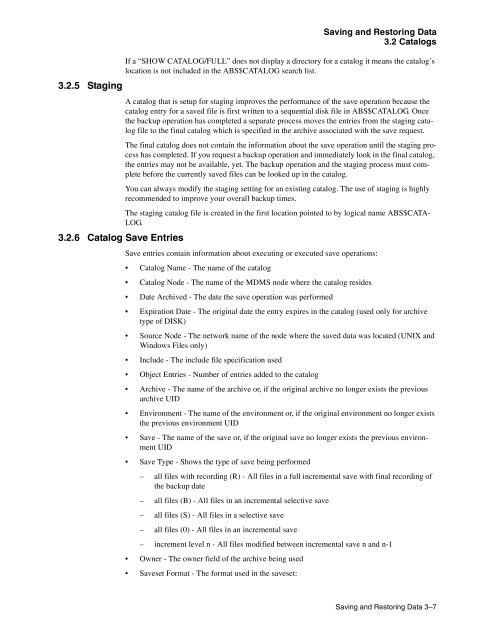HP Archive Backup System for OpenVMS Guide to Operations
HP Archive Backup System for OpenVMS Guide to Operations
HP Archive Backup System for OpenVMS Guide to Operations
Create successful ePaper yourself
Turn your PDF publications into a flip-book with our unique Google optimized e-Paper software.
3.2.5 Staging<br />
3.2.6 Catalog Save Entries<br />
Saving and Res<strong>to</strong>ring Data<br />
3.2 Catalogs<br />
If a “SHOW CATALOG/FULL” does not display a direc<strong>to</strong>ry <strong>for</strong> a catalog it means the catalog’s<br />
location is not included in the ABS$CATALOG search list.<br />
A catalog that is setup <strong>for</strong> staging improves the per<strong>for</strong>mance of the save operation because the<br />
catalog entry <strong>for</strong> a saved file is first written <strong>to</strong> a sequential disk file in ABS$CATALOG. Once<br />
the backup operation has completed a separate process moves the entries from the staging catalog<br />
file <strong>to</strong> the final catalog which is specified in the archive associated with the save request.<br />
The final catalog does not contain the in<strong>for</strong>mation about the save operation until the staging process<br />
has completed. If you request a backup operation and immediately look in the final catalog,<br />
the entries may not be available, yet. The backup operation and the staging process must complete<br />
be<strong>for</strong>e the currently saved files can be looked up in the catalog.<br />
You can always modify the staging setting <strong>for</strong> an existing catalog. The use of staging is highly<br />
recommended <strong>to</strong> improve your overall backup times.<br />
The staging catalog file is created in the first location pointed <strong>to</strong> by logical name ABS$CATA-<br />
LOG.<br />
Save entries contain in<strong>for</strong>mation about executing or executed save operations:<br />
• Catalog Name - The name of the catalog<br />
• Catalog Node - The name of the MDMS node where the catalog resides<br />
• Date <strong>Archive</strong>d - The date the save operation was per<strong>for</strong>med<br />
• Expiration Date - The original date the entry expires in the catalog (used only <strong>for</strong> archive<br />
type of DISK)<br />
• Source Node - The network name of the node where the saved data was located (UNIX and<br />
Windows Files only)<br />
• Include - The include file specification used<br />
• Object Entries - Number of entries added <strong>to</strong> the catalog<br />
• <strong>Archive</strong> - The name of the archive or, if the original archive no longer exists the previous<br />
archive UID<br />
• Environment - The name of the environment or, if the original environment no longer exists<br />
the previous environment UID<br />
• Save - The name of the save or, if the original save no longer exists the previous environment<br />
UID<br />
• Save Type - Shows the type of save being per<strong>for</strong>med<br />
– all files with recording (R) - All files in a full incremental save with final recording of<br />
the backup date<br />
– all files (B) - All files in an incremental selective save<br />
– all files (S) - All files in a selective save<br />
– all files (0) - All files in an incremental save<br />
– increment level n - All files modified between incremental save n and n-1<br />
• Owner - The owner field of the archive being used<br />
• Saveset Format - The <strong>for</strong>mat used in the saveset:<br />
Saving and Res<strong>to</strong>ring Data 3–7

















